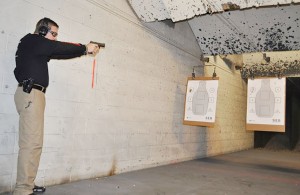by Chris Cerino
Teaching someone to shoot takes time, patience and quite a bit of knowledge in the fundamentals of marksmanship.
Shooting never came easily for me. It took time to create the skills I now have. If an instructor said it, I did it. Not knowing any better, I followed their lead. Wanting only to be better, I never thought to ask the “why” questions when it comes to stance or platform, as they instructed. I should have been asking questions.
Despite instructors’ skill levels, there are three things they will generally focus on when training shooters. Safety, the importance of the front sight, and stance. Due to my background, I’ve experienced many instructors. Some couldn’t hit the broad side of a barn if they were standing inside of it. They rarely shot in front of us, and hardly ever carried a gun. Boy though, could they bark about those three things.
“Don’t bend over on the line!”, “Hands behind your back when done firing!”, “Finger out of the trigger guard and dress that shooting line up!” they bellow. When not hammering safety, they yelled incessantly about staring at the front sight. They failed to address sight alignment or sight picture, but insisted shooters get hard on that front sight. The same instructors would stare at a shooter who’s shooting low and left and declare, “I don’t know what she’s doing. Try bringing your strong foot back.”
I’ve learned things through experince and trial and error. I can tell you that bringing your strong foot back isn’t going to bring your shots up and centered. Yet, stance is one of the first things discussed in almost any shooting curriculum. The word stance sounds to me very planted or rooted, as if your feet were socked in cement. In the competitive or combative realm, you are very rarely in one place long.
I much prefer the term “platform” to stance. The shooting platform entails “feet, knees, hips and shoulders squared to the target.” If I ever have students stand with their feet shoulder width apart, I get people spreading their feet out so far they look like they are riding an imaginary horse. They place their feet outside of the actual muscle of their shoulders.
To find shoulder width, think about where your arms join your shoulders (at the joint). Then think about where your feet are beneath you when you walk. Shoulder width is where you shoot from as well as move from.
When feet get spread out too far, it becomes hard to immediately move forward or rearward. You will first need to shift weight to bring your feet back underneath you and then you can begin to move. If your shooting platform takes movement before you can move, you’re wasting precious time.
The most important detail of stance is a slight weight shift forward. Even this is necessary only to run the gun hard and fast. Recoil management actually starts at the grip and ends just about at your shoulders. Having weight forward helps and is best described as “nose over toes” or “shoulders just in front of your hips.”
An easy way to get the necessary amount of forward weight shift is to stand with feet shoulder-width apart and with feet, knees, hips and shoulders squared to the target. Then try one of these techniques.
The Belly Crunch—Easily my favorite, you too will like this if you are familiar with the abdominal exercise. When standing, do a simple ab crunch bringing your buttocks in and shoulders forward to create abdominal tension. While doing this you can see how your nose comes forward over your toes with shoulders just in front of the hips.
Grabbing the Carpet (big toe down)—Pretend you are standing on a soft shag carpet. With your non-dominant foot, scrunch up your toes as if trying to grab that shag carpet. Your body should come forward about two inches, bringing your nose over your toes.
If you can’t grab the carpet, try pretending there is a penny under your weak side big toe. Press the penny into the floor with your big toe; you get the same effect. Nose over toes!
This forward weight is generally all you need to run most common pistols and ARs. If I were to shoot a shotgun, I would bring my strong foot back to stiffen my posture up a bit, but it’s not much.
Often, people struggle with stance, trying to get their feet just right before they shoot. You can’t be worrying about your feet when time is of the essence. To fix those worrywarts, I have them stand like a “bowling pin” with their feet together touching (balls and heals) while shooting. The only concern is weight shift.
Once they realize they can fire from that position, they seem to relax and become more focused on the important fundamentals of sight alignment, sight picture and trigger management. By dispelling the myth of stance I can get shooters to perform more quickly with economy of motion and dedication of focus to what actually gets the hits.
Certain fundamentals should get plenty of attention. Learn to focus on them. Foot placement has nothing to do with your ability to hit consistently. When you start shooting on the move and firing from alternate positions, your body will just do what’s necessary to manage the gun.
It’s all about the fundamentals.
Chris Cerino is a firearms instructor, competitor and TV personality who’s been training law enforcement officers and military for more than 18 years. Literally immersed in training for years, his skills are founded in real life experience. Chris is the director of training for Chris Cerino Training Group LLC, and teaches in a “do as I do” fashion. Contact him by email at: chris@cerinotraininggroup.com, phone: 330-608-6415.






